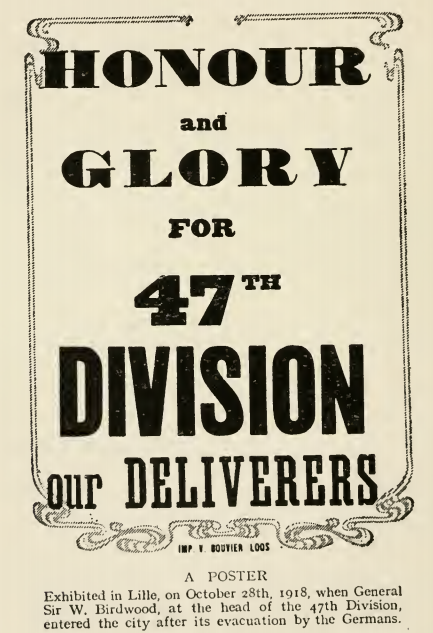Chapter 16 – The Last Phase and Demobilisation.
In Billets at Raimbert.
The Battalion was very pleased to be back at Raimbert, where billets were good and here kindly inhabitants retained a happy recollection of the previous visits of the London Irish. Unfortunately, very many of the officers and men, who had helped to establish the Battalion’s excellent reputation in the village, had been killed or wounded since the last rest in Raimbert but the tradition lived on and the Battalion was made very welcome.
The usual rest area training followed, with plenty of drill and open order exercises in the vicinity.
There was a reasonable amount of leisure, and boxing contests, football matches and visits to Lilliers and the surrounding villages comprised the Battalion’s principal diversions. The London Irish concert party, “The Shamrocks” gave many excellent shows and the Battalion orchestra was much in demand.
Rumours of a change of front were current and, on 18th September, confirmation was received that the Division had orders to proceed to Italy. The prospect was extremely pleasing and, while the Battalion did not anticipate being as fortunate as the 2nd Battalion London Irish Rifles in “seeing the world”, the proposed transfer to Italy gave great satisfaction.
Earlier in the war, there had been expectations of a transfer to another front, Egypt was strongly fancied then as a rumour had spread to the effect that camels, troops for the use of, in bundles of ten, were parked in the Quartermaster’s Store. To the great disappointment of the troops, the move to Italy was declared off, but it was some consolation to know that every day brought tangible indications of enemy collapse.
Allied arms were achieving successes everywhere and, on the Western Front, the enemy was in retreat.
Transfer to the 5th Army and a Move from Raimbert.
On 1st October, orders were received that the 47th Division would be transferred to the 5th Army (from the 1st) and that the move would take place by rail.
The Battalion, which had, on 27th September, marched from Raimbert to Pierremont, en-trained on 1st October at 630pm at St Pol Station en-route for Merville.
On reaching Merville at 730pm, the Battalion de-trained and marched to bivouacs in a field near Lestrem, arriving about 2am on 3rd October.
Following the Retreating Enemy.
The 141st Brigade was ordered to relieve 176th Brigade of the 59th Division, and to follow the retreating enemy. Pressure was to be maintained, but heavy fighting was to be avoided.
The relief took place on the night of 2nd/3rd October, the London Irish taking over a series of breast works south west of Laventie. At 7am on 3rd October, the Brigade moved forward, with the London Irish on the right, 20th Battalion in the centre and 19th Battalion on the left.
Led by a screen of patrols, the Battalion advanced due east in artillery formation. Enemy opposition was not severe at the outset and German patrols moved back as the line advanced. South of Fromelles, enemy machine guns and snipers were active and 2nd Lt JK O’Donoghue and thirty other ranks were wounded. The London Irish came under heavy artillery and machine gun fire from Le Maisnil and the enormous amount of wire at this point made progress difficult. As the troops pushed on, the enemy artillery fire ceased although, on the right, there was still considerable machine gun fire but the German parties retired when attacked.
By 130pm, the London Irish had reached a line from the road east of Bas Flandre (on the south) back to the Le Maisnil–Bas Flandre road (on the north), having passed Laventie, a heap of ruins, and Aubers, and its famous ridge on the right.
The ground was in fair condition for marching, but there were many obstacles such as woods, dykes old German stables, huts and buildings, which impeded progress and made it difficult for the forward screen of patrols and the Battalion to keep in touch.
The advance of the London Irish was somewhat delayed until troops of 74th Division came up to the Fourne-en-Weppes to Bas Flandre road but, at 530pm, the whole line moved forward again, the London Irish proceeding towards Beauchamps-Ligny and Chateau de Flandre. The country between Le Maisnil and Radinghem-en-Wepps was tricky, bestrewn with barbed wire and enemy defences and, in consequence, the screen of patrols had no easy task. All dugouts, shelters and trenches had to be searched for enemy troops and booby traps and these very necessary tasks occupied some time.
A Patrol by 2nd Lt Johnson.
At about 6pm, 2nd Lt EP Johnson and his platoon (accompanied by RSM Fuller) reached Radinghem-en-Weppes. No other British troops were in sight and, with both flanks in the air and the main body out of touch, 2nd Lt Johnson posted his men in a trench about 100 yards west of Radinghem-en-Weppes, from which the village and the main road could be controlled. In the trees were look out platforms and from these vantage points, when light permitted, the ground was scoured, without success, for signs of other British troops. A mounted staff officer appeared “out of the blue” and congratulated the party on being in the right place and on time, and as suddenly disappeared.
2nd Lt Johnson’s party was fired on at 630pm from Radinghem-en-Weppes by enemy artillery and sustained some casualties. About 730pm, 2nd Lt King and a small party arrived and later contact was made with some of the leading troops of 20th Battalion. 2nd Lt Johnson took charge and disposed the men for the night so that the flanks and front were protected.
The Advance Continues.
On 4th October, the advance was resumed and, at dawn, 142nd Brigade passed through 141st Brigade. The London Irish side slipped and proceeded due east in support of 19th and 20th Battalions.
Good progress was made by 19th and 20th Battalions until they came against the enemy’s outpost line, the railway embankment three quarters of a mile east of Radinghem-en-Weppes. The position, which afforded excellent cover, was well protected by machine guns and wire, and was held in strength. Without risking heavy fighting, no further advance was possible.
On 5th October, the Brigade was relieved by 140th Brigade and the London Irish, on arrival of 15th Battalion, moved about one and a half miles west of Radinghem-en-Weppes. In this position, the Battalion rested until 9th October when, after dusk, it moved forward and relieved 21st Battalion in the front line.
The line was very quiet and, apart from some slight artillery fire including tallow cross gas shells, the enemy was not active.
On 14th October, an advice was received from Brigade that a German wireless message, ordering withdrawal, had been tapped. Patrols ascertained that this movement was in progress and that the railway embankment had been evacuated.
Relief from Line Duties.
On 16th October, the Battalion was relieved by 72nd Infantry Brigade and withdrew at noon to a point near Fromelles. The Battalion en-trained at 3pm and, on arrival at Estaires at 5pm, proceeded to billets.
A further move was made on 17th October when the Brigade group proceeded to the Berguette-Lambres area. The Battalion en-trained at La Gorgue station and travelled by a returning supply train to Aire-sur-la-Lys and then continued by march route to Lambres
Notification of Decorations.
Notification of the undermentioned decorations was received on 24th October:
Decoration.
DSO – Lt-Col GH Neely MC.
Bar to MC – Capt CF Burnay MC.
MC – Capt TFG Carless.
MC – Capt FGH Wraight.
MC – Capt CA Fea.
MC – 2nd Lt CH Gibbon.
MC – 2nd Lt FE Taylor.
MC – 2nd Lt GHR Stancourt.
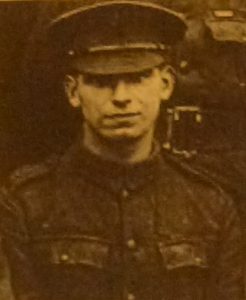
DCM – CSM J Tilby.
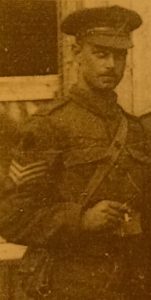
DCM – CSM R Fuller.
Preparing for the Official Entry into Lille.
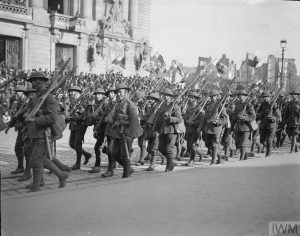
The Brigade moved into the Lomme area on 24th October, the London Irish leaving Lambres at 915am by march route to Berguette Station. The Battalion proceeded by train to Perenchies, thence by route march to Lomme, billeting on arrival in empty houses.
In preparation for the official entry into Lille, the Battalion spent 27th October cleaning up.
On 28th October, the Battalion, in fighting order, left Lomme for the ceremony and moved in the following order: Band, Headquarters, “A”, “C” and “D” Companies, 2 cookers, 4 limbered wagons and 1 water cart. “B” Company had proceed earlier to form a cordon round the Grande Place.
The GOC 47th Division, followed by his staff, led the Division to Porte de Cantelu, at which point GOC 5th Army (General Birdwood) and GOC XI Corps (Lt Gen Sir R Haking) joined and rode in front of the column as far as the Grande Place.
The column halted for ten minutes, while General Birdwood presented his standard to the Mayor of Lille. General Birdwood, GOC XI Corps and GOC 47th Division dismounted and took their seats on the stand. The column, led by 142nd Brigade, marched through the Grande Place, where a large gathering of Staff Officers, the Civic heads of Lille and Mr Winston Churchill were seated.
During the march, XI Corps Band played in the Place de la Republique and the Grande Place and regimental bands played through the town.
The populace showed the greatest enthusiasm and heartily cheered the troops as they marched at attention through the gaily decorated streets.
A link to a newsreel showing of the parade can be found here:
After the march, the Battalion proceeded to billets in the Faubourg de Fives, where all the Officers and most of the men enjoyed the thoroughly unusual luxury of a night in beds.
Casualties in October.
Casualties reported for the month of October were:
Officers – 2nd Lt JK O’Donoghue (wounded), Acting Captain R McDonald (POW).
Other Ranks – 10 killed, 54 wounded, 8 missing.
Billets Shelled.
After a day in billets, the Battalion moved on 30th October to Willems and, on the following day (31st October), proceeded to Templeuve. 19th Battalion’s position in support was reconnoitred on 1st November by the CO and Company Commanders and, on 2nd November, the Battalion moved off at 415pm to take over billets in Houilly. Headquarters, “A”, “B” and “D” Companies were billeted in houses occupied by civilians and “C” Company had two platoons in empty farms round Rumez and the remainder at Ramegnies-Chin. The Germans shelled heavily with HE and gas during the night, obtaining a direct hit on a barn occupied by “A” Company and several gas (yellow cross) casualties were caused.
A Patrol by Lt Ashridge.
On the following evening, 3rd November, two London Irish patrols, one under Lt Ashdridge and the other under Sgt JW Cullen, crossed the L’Escaut Canal and reconnoitred the ground to the east. The method of crossing the Canal was by means of a plank lashed to two casks, with a line at each end. The first one was pushed over and the plank was then pulled backwards and forward until the whole patrol was over. The patrols climbed the steep bank on the far side and explored the enemy territory. Trench mortar emplacements and machine gun posts were located and, on returning, Sgt Cullen discovered a usable temporary bridge, which the enemy had failed to destroy.
Both patrols brought back valuable information and their work was especially commented on by the Major General.
In the Line at Pont-a-Chin.
The Battalion went into the line on 4th November and relieved 19th Battalion at night at Pont-a-Chin, a village straddled across the L’Escaut Canal. “C” Company, on the left, occupied a farmhouse east of Ramegnies-Chin; “B” Company took the centre position in Pont-a-Chin and “D” Company were posted on the right in a chateau on the south side of Pont-a-Chin. “A” Company, in reserve, and Battalion Headquarters occupied parts of a large aeroplane repair shop south west of Pont-a-Chin.
The chateau, in which “D” Company was billeted, was a spacious and elaborate residence with ornamental gardens, which stretched down to the Canal. In the large entrance hall was a magnificent staircase, lighted by a lofty glass dome, while the walls were embellished by many cases of birds, insects and butterflies.
A daylight patrol, consisting of two NCOs, L-Cpl AE Breeze and L-Cpl CH Woolgar and four other ranks, crossed the canal by a plank bridge on 5th November and, about midday, having located an enemy post in marshy land nearby, proceeded to stalk it. The enemy was taken completely by surprise and the post garrison, consisting of five men of the 19th Bavarian Infantry Regiment, was captured. The patrol and their prisoners were fired on when returning, but sustained no casualties. The Germans showed some annoyance at the loss of their men and bombarded the Battalion’s positions. No casualties were sustained, although one trench mortar shell crashed through the glass dome of “D” Company’s chateau.
The Last Days in the Firing Line.
Owing to the terrible weather, the Battalion’s relief, due on 6th November, was postponed 24 hours and 7th November was the last day in which the Battalion spent in the firing line. The enemy was expected to withdraw and three patrols went out at dawn on 7th November to discover whether the retirement had actually taken place. Rifle fire disclosed the fact that the enemy was still in position and 2nd Lt Baxter took a small party out during the morning to engage an enemy post, which had been located. Very unfortunately, this popular young officer, when directing the fire of his men, was struck by a bullet and killed instantly.
At 7pm, the Battalion was relieved by 22nd Londons and marched by companies via Templeuve to Willems and the war was over as far as the London Irish were concerned.
Croix de Guerre Awarded.
The Battalion diary for 9th November records the award of the Croix de Guerre to Rfn EM Moore.
The 47th Division was expected to follow the retreating enemy but, owing to the shortening of the line, the flank divisions extended over the Division’s frontage and it became unnecessary for the 47th Division to proceed beyond La Tombe.
The War Ends.
Hostilities ceased at 11am on 11th November (the Battalion diary does not mention this detail!) and 141st Brigade proceeded to Tournai to take over the picketing of the town. A further move took place on 14th November when the Battalion left Tournai at 9am and marched, via Leuse and Ligne, to Houtaing, arriving at 5pm. Billets were taken over in the stables in the grounds of Chateau La Berliere.
For three days, the Battalion worked in the railway at Ligne, clearing up a portion of the damaged Lille – Brussels line and then moved back in a snow storm to La Tombe on 18th November. After a night at La Tombe, the Battalion marched out at 9am to Peronne in the Sainghin area, via Tournai, where very poor billets were taken over.
Demobilisation.
Returns relating to demobilisation and the Divisional Education scheme became matters of great importance and, under the auspices of the latter, the Battalion, solemnly submitted on 23rd November to an afternoon of “dictation”.
At the end of November, the Division changed its locality and moved by three stages to Lieres. On 27th November: Peronne to Haubourdin via Saighim, Ronchin and Loos; on 28th November: Haubourin to Bethune via Fournes, La Bassee and Annequin; on 29th November: Bethune to Lieres via Chocques and Lillers
November Casualties.
Casualties for November 1918 were:
Officers: 2nd Lt JD Baxter killed.
Other Ranks: 1 killed, 5 wounded, 88 gassed.
December 1918 at Pernes.
The Battalion’s quarters at Lieres were almost unfit for human habitation and, as the result of these conditions, better quarters were found in 5th Army Convalescent Camp at Pernes.
The Battalion spent the whole of December there and, apart from the atrocious weather conditions, contrived to have a reasonably comfortable time. Some military training continued and the Battalion also attended classes in English, French, grammar, shorthand and commercial subjects. In addition, the men had the benefit of special lectures on a variety of subjects delivered by eminent gentlemen sent out from England.
.
Sporting events and concerts were organised and Lt VC Cannan and “The Shamrocks” gave many pleasing performances.
A demobilisation office, under Lt F Haines, opened on 21st December and, on the 22nd, a party left for England, the first demobilisation forms were issued throughout the Battalion and, thereafter, parties of officers and men left for home at various intervals.
New Year Honours.
In the New Year Honours, Capt HA Lane, who had been mentioned in dispatches, was awarded the OBE and Lt PF Keane was the recipient of the Military Cross.
Instruction and Lectures at Pernes.
During January 1919, the Battalion remained at Pernes and the men continued with educational instruction and lectures. There were also daily parades for ceremonial drill and, on 20th January, General Mildren thanked the Battalion for its work in the last phase of the war.
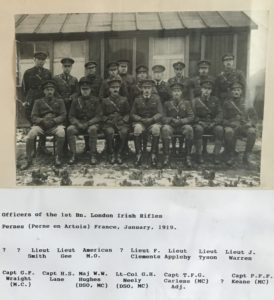
Demobilisation Continues and the Final Performance by “The Shamrocks.”
Eleven officers and three hundred and forty eight other ranks were demobilised in January and, on 1st February, the Battalion’s popular concert party “The Shamrocks” gave a final performance prior to disbandment, owing to the loss of members demobilised.
On 28th March, a draft of two officers, Capt VC Cannan and 2nd Lt AR Smyth and forty eight other ranks left to join 12th Battalion Royal Irish Rifles (Light Division) for duty with the Army of Occupation and, on the same day, Major CF Gorringe KCMG visited the camp to bid farewell on relinquishing command of 47th Division.
By this time, the Battalion was so reduced by leave and demobilisation that fewer than 100 men remained and, as most of these men were employed on various fatigues, military training was out of the question.
The Battalion Returns to England.
On 4th May, the London Irish cadre, with other cadres of the Brigade, en-trained at Pernes at 6pm for Le Havre, where they arrived at 2pm on 5th May. After a few days in camp at Harfleur, the Brigade cadres embarked on SS St George at 5pm on 10th May and proceeded to Southampton, arriving early on the following morning.
Cadres thereupon travelled to Felixstowe to hand in stores and equipment and to await demobilisation.
The London Irish cadre was officially welcomed home by the Mayor of Chelsea on 12th June at the Duke of York’s Headquarters and, at the ceremony, messages were read from HRH the Duke of Connaught, Viscount French and Viscount Esher.
